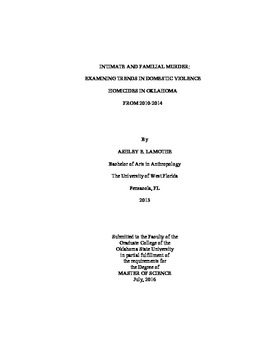| dc.description.abstract | Domestic violence homicides, particularly involving intimate partners, have been the subject of research for many decades. What has been lacking in the literature, however, is an in-depth comparison of the many types of relationships that fall under the umbrella definition for domestic violence. Such relationships include parents, siblings, grandparents, and other family members, as well as roommates. This study focuses on the trends and characteristics of the domestic violence homicides that occurred in the state of Oklahoma from January 2010 through December 2014. A total of 1318 homicides were reviewed and 368 were determined to meet the definition of domestic violence homicide. For this study, domestic violence is defined by Title 22 of the Oklahoma State Statutes in the Protection from Domestic Abuse Act. For each domestic violence case, several pieces of information were collected. Data collected were: demographics of the victim and offender, relationship between victim and offender, the mechanism of injury that caused the death, the number of injuries to the victim, drug or alcohol use by either the victim or offender, and the county where the death occurred. The collected variables were then analyzed using 2-way contingency tables and Pearson’s chi-square to test significant associations between the variables. Significant association were found between: offender type and the sex of the offender, offender type and sex of the victim, offender type and race of the offender, race of the offender and mechanism of injury, offender’s age and mechanism of injury, offender type and mechanism of injury, offender type and number of injuries to the victim, mechanism of injury and sex of the victim, mechanism of injury and race of the victim, mechanism of injury and age of the victim, offender type and drug and/or alcohol use of the victim or offender, and mechanism of injury and drug and/or alcohol use of the victim or offender. The conclusions in this study do not match those reported in recent studies on national data in aspects concerning mechanism of injury and perpetrator types. Furthermore, this study illustrates the prevalence of family homicides despite their exclusion from the literature on domestic violence. | |
